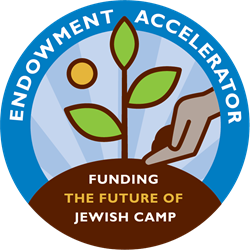
As a program of the Harold Grinspoon Foundation (HGF), JCamp 180’s mission is to strengthen the long-term organizational effectiveness and financial sustainability of nonprofit Jewish camps to ensure our community’s future and connection to Judaism.
Please note that The Harold Grinspoon Foundation are not financial advisors. We can offer sample policy language and guidance about where you can seek financial advice but cannot provide that advice ourselves.
Securing Camp’s Future with a Permanent Endowment
JCamp 180 and the Harold Grinspoon Foundation believe that endowment should be an essential piece of Jewish camps’ financial model for a sustainable future. That is why we have created the Endowment Accelerator Matching Grant and related resources like this toolkit.
We encourage JCamp 180 camps to consider creating or growing your permanent endowment to assure your camp’s long-term organizational effectiveness and financial stability, helping to assure that your special brand of Jewish camp experience is available to future generations of Jewish children and young adults.
Why Endowment Building?
A permanent endowment is a pool of funds invested for long-term growth and income, where a portion of the income each year supports camp’s operations and programs. The defining feature of a permanent endowment is that the principal (the assets gifted to the fund) stays in the fund in perpetuity (forever) and grows year after year.
A permanent endowment can help minimize future financial burdens on camp by guaranteeing income in addition to operating revenue and annual fundraising results. Building your permanent endowment is also a great opportunity for your donors to make a lasting impact on camp. Through a gift to your permanent endowment, donors can feel secure knowing they will help generate income for camp to thrive for future generations.
You can build your permanent endowment in a number of ways.
- Camps may fund their endowments using operating surpluses, excess reserve funds, unrestricted bequests, or a windfall from the sale of an asset.
- Many donors will respond to a compelling ask by making current gifts of cash or other assets to establish and grow your endowment.
- And your camp can inspire even more supporters to make significant gifts to your permanent endowment through after-life legacy gifts via their wills, retirement plans, or life insurance.
In combination, these methods offer a powerful, comprehensive approach to accelerating the growth of your camp’s permanent endowment.
This toolkit is designed to help move your camp’s leadership through five steps to success in building a permanent endowment:
- Assess your readiness to embark on an endowment-building effort;
- Understand how a permanent endowment fits into your camp’s financial goals;
- Explore your options for creating or building your endowment fund and refreshing your endowment-related policies;
- Plan for success in creating a new endowment or growing your existing permanent endowment;
- Develop meaningful relationships with your endowment donors that last a lifetime.
This guide is designed to be used by all camps, whether you are exploring the concept of a permanent endowment for the first time, looking for tips to boost your existing endowment fundraising, have a legacy program or not, or are somewhere in between.
Remember: Your JCamp 180 Relationship Manager is always available for additional support as you move through your endowment journey!
Note: You can download one document with all the linked resources here.
Tookit Version 1, December 2023